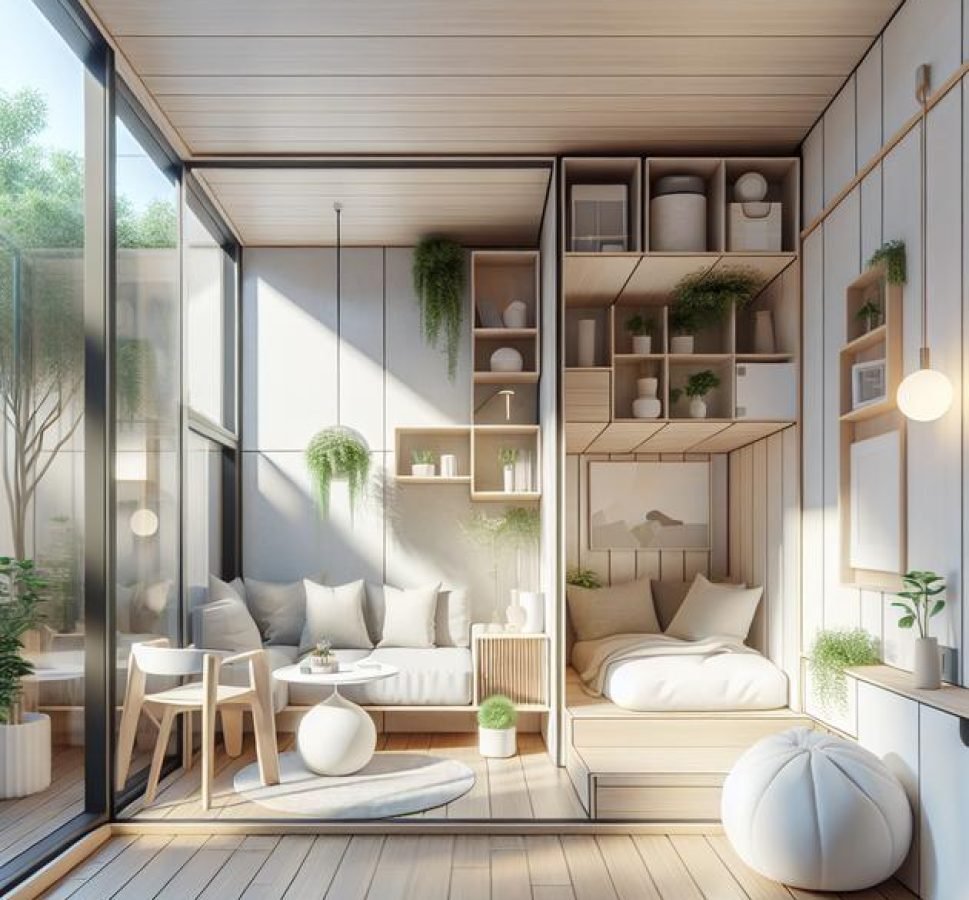Tiny home interior design focuses on maximizing space through smart storage solutions, multi-functional furniture, and efficient layouts, emphasizing simplicity and practicality to create functional yet stylish living spaces within limited square footage.
Ever wondered how to make the most of a tiny space? Let me tell you, tiny home interior design is about more than just functionality. It’s about creating a cozy, inviting space that feels like home. Who knew that something so small could have such a big impact?
maximizing natural light
Natural light can transform a tiny home, making it feel larger and more inviting. By strategically placing windows and using translucent materials, you can maximize the available sunlight. Opt for large windows where possible, and consider using skylights to bring light in from above. Mirrors and light-colored walls can reflect sunlight, enhancing the brightness of the space. Choose sheer curtains instead of heavy drapes to allow light to filter in without obstruction. Keeping your windows clean and decluttering the space around them is also crucial, as this ensures that light passes through unhindered and illuminates every corner of your home.
To enhance the light further, arrange your furniture to avoid blocking windows. Open, airy spaces around windows let light flow throughout the room. Additionally, interior glass partitions and doors can help distribute natural light between rooms, ensuring that even spaces far from exterior windows can benefit from it. A deeper integration of nature with your interior can also be achieved by planting indoor greenery near windows, creating a seamless indoor-outdoor connection and adding vibrancy to the space.
color schemes for small spaces
Choosing the right color schemes for small spaces can dramatically impact how a room feels. Light colors like whites, creams, and pastels can make a space seem larger and more open. They reflect light, adding airiness to the room. Neutral tones are excellent for creating a calm and cohesive look. You can add pops of color through accessories like cushions, rugs, or artwork to inject personality without overwhelming the space.
Accent Walls
Using an accent wall can add depth and interest to a small room. A bold color or a patterned wallpaper on one wall can draw the eye and create a focal point. Just ensure that the other walls are kept simple to avoid a cluttered feeling.
Consider painting your ceilings a lighter color than the walls, which helps to elevate the space visually. If you prefer a darker palette, opt for soft textures and varied patterns to maintain a cozy and inviting ambiance rather than an enclosed one.
creative storage solutions
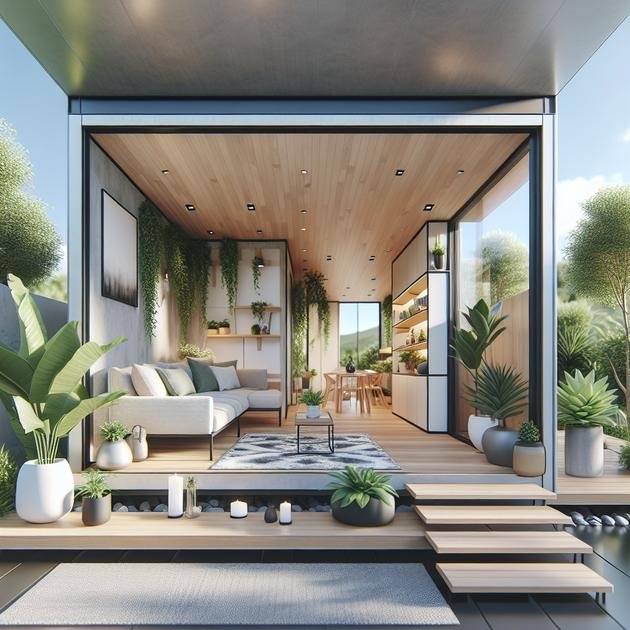
In a tiny home, creative storage solutions are essential to make the most of every inch of space. Consider using multi-functional furniture like ottomans with storage inside or beds with built-in drawers. These pieces serve double duty, providing both utility and style.
Vertical Space Utilization
Maximizing vertical space is key. Install shelves up to the ceiling for storing items you don’t use daily. This not only keeps things tidy but also draws the eye upward, making the room feel larger. Hanging organizers on the back of doors can store shoes, accessories, or cleaning supplies.
Use storage baskets and boxes on shelves to keep smaller items organized and out of sight. Label them for easy access. Under-sink and under-cabinet areas can be fitted with pull-out drawers or racks to maximize storage and accessibility.
Hidden Storage
Look for opportunities to hide storage throughout your home. This could be through “hidden compartments” in stairs or a platform bed with concealed cabinets. The goal is to keep your living space uncluttered while ensuring everything has its place.
multi-functional furniture
Multi-functional furniture is a game-changer in tiny homes, providing both space efficiency and flexibility. Pieces like sofa beds or convertible coffee tables are perfect examples, effortlessly shifting from one function to another as needed. Storage ottomans can serve as seating and hold blankets or other items. Foldable desks can be tucked away when not in use, ideal for maximizing space in work-from-home setups.
In dining areas, consider using extendable tables that can accommodate varying numbers of guests. Wall-mounted drop-leaf tables provide eating space when needed and neatly fold down to free up room afterward. Bunk beds with desks or storage underneath are excellent for children’s rooms, combining sleep and study areas in a compact form.
Custom Solutions
Investing in custom-built furniture can ensure that every piece fits your specific needs and dimensions perfectly. Bespoke built-ins can incorporate shelves, drawers, and even hidden compartments, ensuring no space goes to waste. By thinking creatively about your furnishings, you can make a small home work smarter rather than harder.
using mirrors to create space
Using mirrors strategically can significantly enhance the sense of space in a tiny home. By reflecting light, mirrors can make a room feel brighter and more expansive. Place a large mirror opposite a window to maximize the amount of natural light bouncing around the room, creating an illusion of depth. Wall-to-wall mirrors are particularly effective in narrow spaces like hallways, broadening the area visually.
Consider incorporating mirrored furniture, such as a console table or cabinets with mirrored fronts, to add subtle reflections without overwhelming the decor. Cluster arrangements of smaller mirrors can provide an artistic touch, reflecting textures and colors from different angles. Be mindful of placement to avoid cluttered reflections, keeping the effect harmonious and chic.
choosing the right textiles
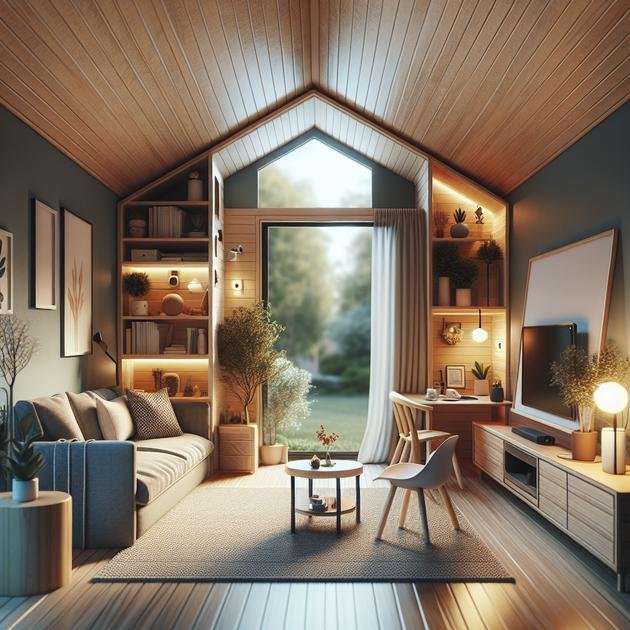
Choosing the right textiles in a tiny home can significantly impact the overall feel and functionality of the space. Opt for lightweight and airy fabrics like cotton and linen for curtains and upholstery. These materials allow for better airflow and natural light while maintaining a fresh, open feel. Incorporating textures, such as woven throws or ribbed cushions, can add depth and visual interest without overwhelming the room.
Consider using multi-purpose textiles that serve more than one function. For instance, a plush blanket can provide warmth and also act as a stylish sofa cover. Look for textiles that are easy to clean and maintain, since tiny homes may not have extensive storage for spare items. When it comes to colors, neutral tones with pops of color can create a harmonious look, making the space feel cohesive and lively at the same time.
Layering and Mixing Patterns
Don’t shy away from layering different textures and mixing patterns. This can create a unique and inviting atmosphere, as long as you maintain a balanced palette. Use patterned rugs or pillows to inject personality and break the monotony of plain surfaces. Just ensure that the patterns complement each other to avoid a chaotic look.
emphasizing vertical design
Emphasizing vertical design in a tiny home is a smart way to maximize space and make an area feel larger. By focusing on height, rather than just floor space, you unlock a new dimension of storage and functionality. Install tall shelves to utilize wall space for storing books, decorative items, or essential supplies. These shelves can draw the eye upwards, creating an illusion of higher ceilings.
Adding vertical elements such as hanging plants or tall floor lamps can introduce layers and depth to your rooms. Consider incorporating wall-mounted solutions like foldable wall desks or compact workstations that free up floor space when not in use. Using curtains that hang from ceiling to floor can also add a sense of grandeur, making the room appear taller.
Vertical Gardens
Vertical gardens are a great way to bring greenery indoors without sacrificing floor space. Use modular systems to create custom plant arrangements that suit your style and space constraints. These gardens not only purify the air but also add vibrant color and life to your home.
small kitchen hacks
Maximizing efficiency in a small kitchen is all about clever use of space and smart organization. Consider installing pull-out shelves in your cabinets, which make it easy to access items stored at the back. Magnetic strips can be attached to walls for storing knives, keeping them safe and freeing up drawer space. Use hanging racks for pots and pans to save cabinet room and add a stylish touch to your kitchen decor.
A folding table or wall-mounted drop-leaf table can serve as an additional countertop when needed, then neatly fold away. Stackable containers are great for storing dry goods, making them easy to identify and access. Utilize the insides of cabinet doors with hanging organizers for cleaning supplies or small kitchen tools.
Smart Appliance Solutions
Opting for compact, multi-functional appliances can save space without sacrificing functionality. For instance, a combination microwave and convection oven can handle multiple cooking tasks. Integrate appliances like a dishwasher drawer that can fit into smaller spaces while still offering full functionality.
bathroom styling in tiny homes
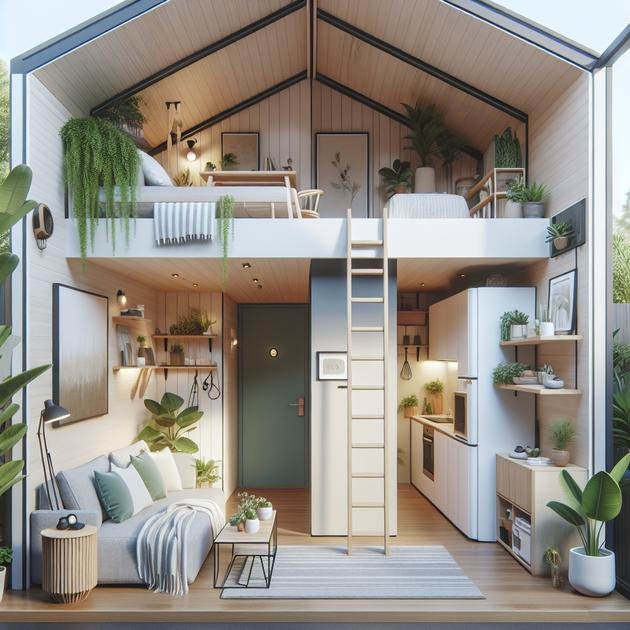
Styling a bathroom in a tiny home requires creativity and efficiency. Opt for compact fixtures like corner sinks and wall-mounted toilets to save valuable floor space. Use a large mirror to reflect light and create a sense of openness. Consider installing a floating vanity that offers storage underneath while keeping the floor visible, which helps the space feel larger.
Choose light colors and reflective surfaces to enhance brightness. Open shelving can be a stylish and practical storage solution, allowing you to showcase neatly arranged towels and essentials. Consider using glass shower doors rather than curtains to maintain an open feel, as they don’t visually cut off space.
Smart Storage Solutions
Utilize vertical space with tall cabinets or shelves over the toilet or on other walls to store toiletries and spare towels. Baskets and trays can help organize items while adding warmth to the decor. For a touch of luxury, incorporate small yet exquisite details like stylish hardware and elegant light fixtures.
personalizing your tiny home
Personalizing your tiny home is all about adding touches that reflect your style and make the space uniquely yours. Start by selecting a color palette that resonates with you. Use decorative accents like pillows, rugs, and artwork to bring colors and textures that reflect your personality.
Incorporate customized furniture to fit your functional needs and aesthetic preferences. Whether it’s a reading nook with built-in shelves or a custom-made dining table that fits perfectly in your kitchen area, tailor-made pieces can maximize comfort and usability.
Adding Personal Touches
Display personal collections or souvenirs that have sentimental value. This could be through a gallery wall of your favorite photos or a shelf dedicated to travel memorabilia. Choose lighting that adds character, such as pendant lights or vintage lamps, to enhance the ambiance.
Consider using plants to bring life to your home. From potted herbs in the kitchen to hanging plants in the living area, greenery can create a vibrant and inviting atmosphere. These elements together make your tiny home not just a place to live, but a true sanctuary that feels like you.
creating outdoor-indoor flow
Creating a seamless outdoor-indoor flow in a tiny home can enhance the sense of space and connectivity with nature. Consider installing large glass doors or sliding panels that open up to an outdoor deck or patio. This not only floods your interior with natural light but also extends your living area into the outdoors.
Use consistent flooring materials to blur the lines between inside and out. For example, using weather-resistant tiles both in the interior and on the patio can create a unified look. Outdoor rugs and cushions in similar colors and patterns as your indoor soft furnishings can tie the spaces together visually.
Incorporating Greenery
Integrate plants both inside and outside to create a cohesive environment. Place potted plants near entrances to create a natural transition. Consider also adding a vertical garden on an exterior wall that can be admired from inside, enhancing the view. With these thoughtful touches, your tiny home will feel more connected to the outdoors, offering an airy and expansive feel.
energy-efficient design tips
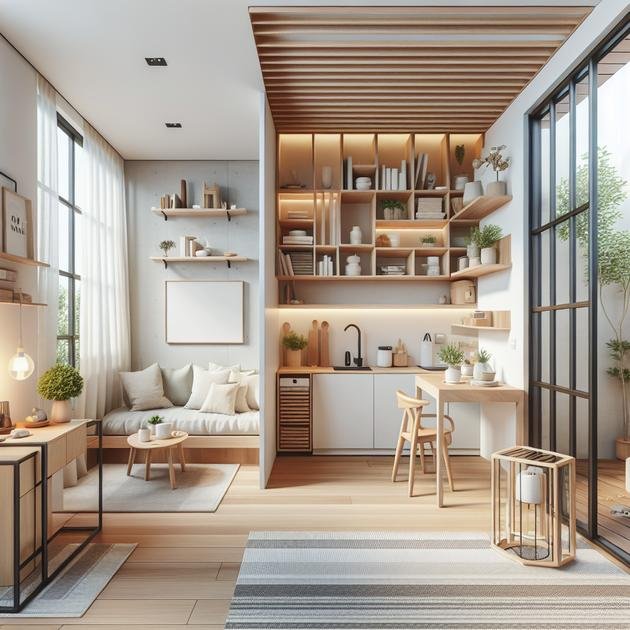
Energy-efficient design in tiny homes is crucial for sustainability and cutting costs. Start by selecting insulated windows and doors to minimize heat loss. Double-glazed windows are an excellent choice for maintaining indoor temperatures. Consider using energy-efficient lighting like LED bulbs, which consume less power and last longer than traditional options.
Install solar panels to harness renewable energy. Even a small array can significantly reduce reliance on the grid. Optimize insulation by using eco-friendly materials in walls and ceilings to keep the indoor climate stable year-round.
Smart Appliances
Invest in energy-efficient appliances that use less water and electricity. Look for the ENERGY STAR label when choosing refrigerators, dishwashers, or HVAC systems. A smart thermostat can help regulate heating and cooling more efficiently, adapting to your lifestyle and preferences.
Incorporate passive solar heating by positioning your home to take advantage of natural light. South-facing windows can collect heat during the day, reducing the need for artificial heating. These tips not only help to save on energy bills but also contribute positively to the environment.
budget-friendly design choices
Designing a tiny home on a budget doesn’t mean sacrificing style or functionality. Start by selecting versatile, affordable materials like plywood or recycled wood for furniture and cabinetry. These materials can be stylishly finished and are easy on the wallet.
Upcycle and repurpose items you already have. A little creativity can transform old furniture into unique pieces, such as turning crates into shelves or pallets into a coffee table. Second-hand stores and online marketplaces are excellent sources for finding budget-friendly decor and furniture that can be refreshed with a new coat of paint or fabric.
DIY Decor
DIY projects are a great way to personalize your home while saving money. Create your own art from canvases or fabric prints that can add color and texture to your walls. Craft your own curtains or cushion covers to bring a personalized touch to your space. Wall decals are an inexpensive way to add visual interest and can be easily replaced when you want a change.
Lighting can also be stylish and budget-friendly. Use LED string lights or vintage-style bulbs to add warmth and ambiance without breaking the bank. With these budget-friendly choices, you can create a stylish and functional tiny home that reflects your personality and needs.
trending tiny home styles
Exploring trending tiny home styles helps personalize your space while staying current with design innovations. One popular style is the modern minimalist, which emphasizes clean lines, neutral colors, and functional furnishings. This approach maximizes space with an uncluttered look and incorporates smart technology for convenience.
The rustic chic style combines natural materials like reclaimed wood and stone with cozy textiles. This style brings warmth and character, often incorporating vintage or distressed pieces that add uniqueness and appeal.
Bohemian Vibes
The bohemian style is gaining popularity for its bold use of colors, patterns, and textures. In a tiny home, incorporate layered textiles, hanging plants, and eclectic art to create a vibrant and free-spirited atmosphere. Use light fixtures and decor items that bring in metals and stones for added flair.
Another trending style is the industrial look, featuring exposed beams, metal accents, and open spaces. This utilitarian style works well in tiny homes by highlighting architectural elements that provide character and function. Each of these styles allows for a personal touch while keeping your tiny home inviting and stylish.
space-saving decorating ideas
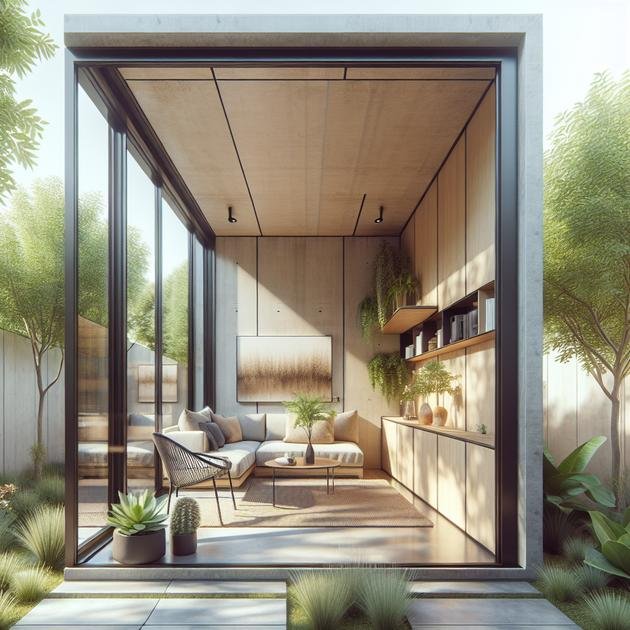
Space-saving decorating ideas are essential for making the most of a tiny home. Consider using multi-purpose furniture to maximize function without crowding the space. A sofa that converts into a bed or a coffee table with storage underneath can provide utility while looking stylish. Floating shelves are another great option, as they keep items off the floor and open up more space.
Utilize vertical space by installing wall-mounted bookcases and pegboards. These can hold books, kitchen utensils, or crafting supplies, keeping everything organized and accessible. Mirrors are a smart decor trick that can make rooms appear larger by reflecting light and creating an illusion of depth.
Minimalistic Accents
Decorate with a focus on minimalism, using simple accents like neutral throw pillows or a single bold art piece to draw attention. By keeping the color palette cohesive, the space feels bigger and less cluttered. Plants can add life and freshness without taking up much room. Choose hanging or small potted plants that don’t overwhelm the space.
For a touch of warmth, integrate soft area rugs that define spaces without barriers. With these ideas, you can create a tiny home that feels spacious, comfortable, and inviting.
implementing smart technology
Implementing smart technology in a tiny home can greatly enhance convenience and efficiency. Start with a smart thermostat to regulate your home’s temperature. It learns your schedule and adjusts heating and cooling to save energy. Smart lighting systems can be automated or controlled via smartphone, reducing energy usage and adding ambiance at the touch of a button.
Consider integrating smart security systems to add an extra layer of safety. Options include cameras, motion detectors, and smart locks that can be monitored and managed remotely. Smart speakers and hubs, like Amazon Echo or Google Home, serve as central command centers for controlling various devices with voice commands, even playing music or answering queries.
Automation and Efficiency
Use smart plugs to turn traditional appliances into smart ones, allowing remote control over lights, fans, or coffee makers. Smart appliances, such as refrigerators or dishwashers, come with features that help manage energy use and improve functionality. Implementing these technologies can make living in a tiny home more enjoyable, efficient, and connected, while saving time and resources.
addressing common design challenges
Addressing common design challenges in tiny homes requires creativity and practical solutions. One frequent issue is the lack of storage space. Consider implementing built-in cabinets and hidden storage areas like under-seat drawers to make use of every nook and cranny.
Lighting can also be a challenge due to limited window space. Use layered lighting with a mix of overhead lights, task lamps, and ambient fixtures to create a well-lit environment. Use mirrors strategically to reflect light and add depth, making spaces feel larger.
Maximizing Function
Maintaining a functional layout in a small space can be tricky. Use versatile and multi-functional furniture, such as fold-away tables or convertible sofas, to maximize the utility of limited floor space. Employ open shelving options to keep frequently used items accessible yet organized. This can help keep surfaces clear and maintain a tidy appearance.
For privacy within open floor plans, consider mobile dividers or curtains that can be drawn when needed and opened up to merge spaces as desired. By addressing these design challenges with thoughtful strategies, a tiny home can be both stylish and fully functional.
Creating Your Perfect Tiny Home
Designing a tiny home involves balancing style, functionality, and personal flair. With thoughtful planning and strategic choices, you can overcome common design challenges and create a cozy and efficient living space.
Whether maximizing natural light, choosing the right textiles, or implementing smart technology, each element plays a crucial role in transforming your tiny space into a home that reflects your lifestyle and needs.
From using vertical design to integrating multi-functional furniture, every decision contributes to making the most of your available space. Embrace the creativity and freedom tiny homes offer, turning limitations into opportunities for innovation.
Ultimately, your tiny home should be a sanctuary that combines comfort, practicality, and personal touches. Enjoy the process of making it uniquely yours.


